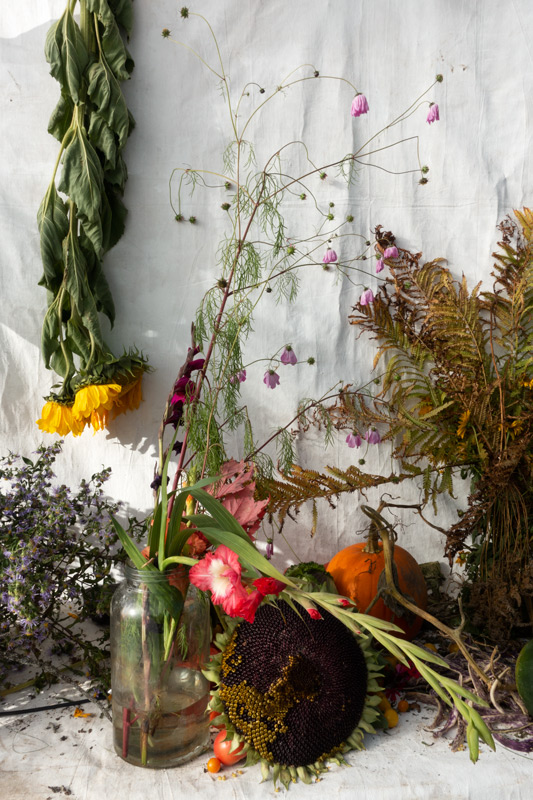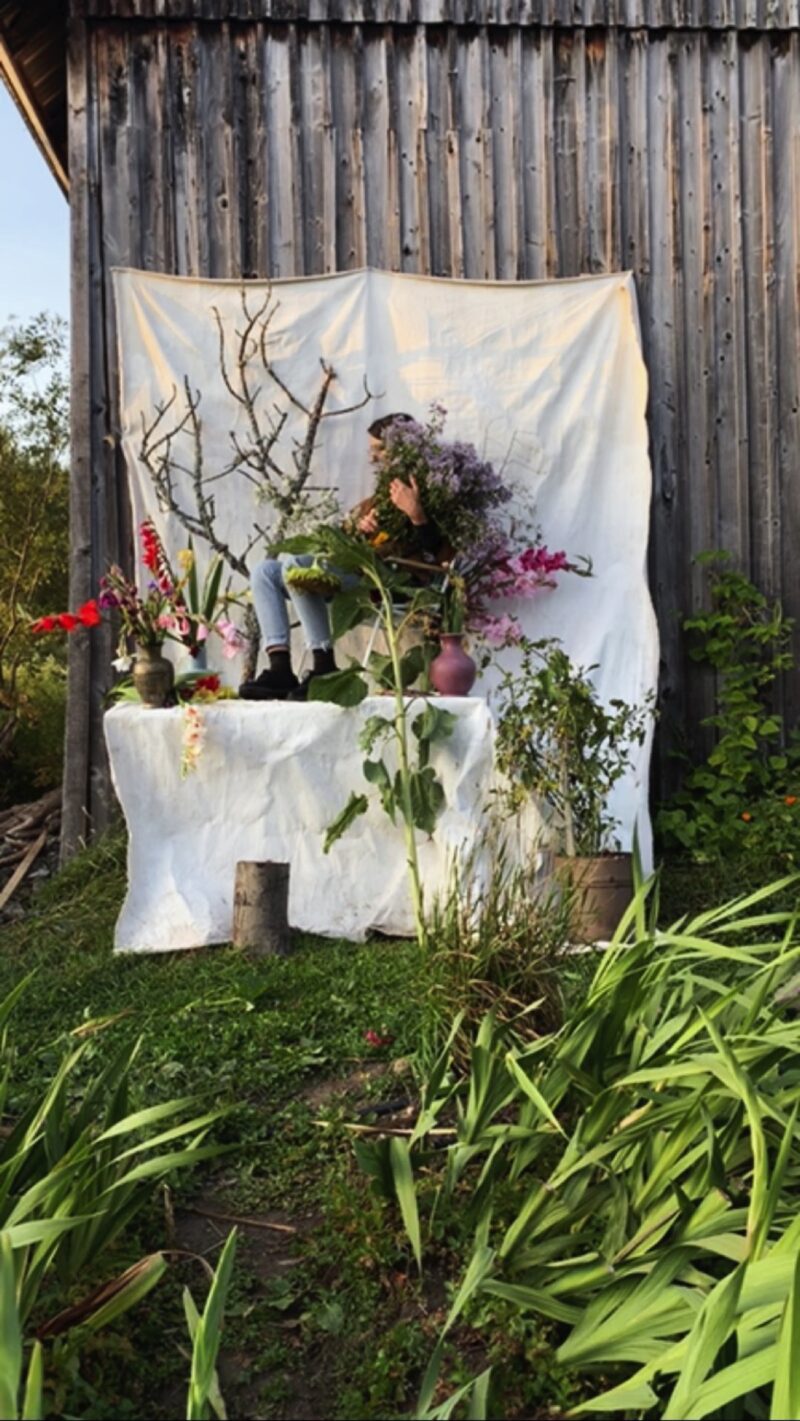[Summer 2021]
Tout t’empêche
By Paule Mackrous
Centre d’exposition de l’Université de Montréal, en ligne / online
While we are recluses in our regions, neighbourhoods, and homes, the pandemic has shrunk the parameters of our living environment, and we are constantly confronted with its limits. It’s what author Cristina Comencini has called “a test of truth.”1 It has led to a wave of migration to rural regions2 and a marked enthusiasm for food autonomy.3 Sara A. Tremblay’s Tout t’empêche emerges in this unusual context. During the 3 fois 3 virtual residency organized by the Centre d’exposition de l’Université de Montréal, she developed a “virtual essay” about her daily life on her small farm in Orford.
The essay, exhibited via Instagram, is punctuated with videos and photographs of harvested flowers, fruits, and vegetables, which are then placed on a large piece of white canvas attached to a barn and covering a table. As these “offerings” are placed on what seems to resemble an altar, the ritualized dimension of the gesture is revealed.
Denis Jeffrey calls that which is created in the present and in private exploration an “instituting ritual” – as opposed to an instituted ritual, which adds to a collective representation that already exists. If this ritual establishes, through repetition, a unique relationship between Tremblay and her living environment, it is through sharing that her symbolic actions, those that divert foods from their primary function, “inform lived experience and give it meaning.” Tout t’empêche becomes a performance, the implementation of a state of mind that is reminiscent of degrowth, defined as “a rejection of the frenzied production of merchandise.”
Tremblay also evades the merchandise effect through slowness and sensory appreciation. Not only does she solicit the contemplative gaze by drawing on the formal aspects of spaghetti squashes, sunflowers, or varieties of beans, but the edible plants produce effects on our bodies, they are “turned toward sensations.” So, we almost have the impression that we can feel, taste, and touch the “blueberries from Robert’s place” or the cherry tomatoes whose harvesting and culinary preparation are unveiled to us through long, intimate videos. A counterweight is thus offered to both the direct and the indirect effects of COVID-19, such as anosmia and ageusia (loss of the senses of smell and taste), physical distancing, and the requirement to touch nothing – effects that prevent us from experiencing all the sensory dimensions of the world.
Because these “still lifes” encompass the light, the wind, the frost, the sounds of insects and birds at dusk and coyote cries at night, Tout t’empêche also reveals the life of the ecosystem and the interactions that constitute it over time. For instance, just a small “gap in the clouds” creates a unique effect on red gladioli, flowers that announce autumn and whose recurrence in the images acts as a structuring element – Tremblay notes that she has planted more than a thousand gladiola bulbs! Similarly, we see that the things presented begin a second life after being harvested and used in Tremblay’s composition: that of decomposition or being tasted. This life takes shape in the encounter of the “specimen” with other organisms, such as insects or fungi, or with our digestive system, until they totally disappear.
For many of us, home has become workplace. Conversely, Tremblay wonders “what happens when the place where we take refuge, to create, becomes our main residence?” The result is the sharing of what is perceptible in daily life: the deployment of a connection that Tremblay weaves with the natural environment, and with her food. It is through this shaping, this continuous creation of the future, that their inseparability is made visible. Translated by Käthe Roth
1 Cristina Comencini, « Chers cousins français », Libération, 12 mars 2020, tiré de https://www.liberation.fr/livres/2020/03/12/coronavirus-chers-cousins-francais-par-cristina-comencini_1781454/
2 Jean-François Guillet, « Exode des Montréalais vers les régions : un phénomène bien tangible », La Voix de l’Est, 24 juillet 2020, https://www.lavoixdelest.ca/actualites/exode-des-montrealais-vers-les-regions-un-phenomene-bien-tangible-b02dcccb8cc4c79bd0485e063a892d9b
3 On remarque cet engouement, non seulement dans les discours lors des points de presse du gouvernement du Québec, mais aussi dans les articles de journaux. On note aussi la popularité accrue des jardineries, des semenciers et des entreprises d’aménagement horticole.
4 Jeffrey, Jouissance du sacré, religion et postmodernité, Paris, Armand Colin, 1998, p. 57.
5 Idem.
6 Yves-Marie Abraham, Guérir du mal de l’infini. Produire moins, partager plus, décider ensemble, Montréal, Éditions Écosociété, 2019, p. 22.
7 Carolyn Korsmeyer, « Esthétique indigeste », Cités, vol. 75, no 3, 2018, p. 35.
8 Sara A. Tremblay, presentation text on the website of the Centre d’exposition de l’Université de Montréal, https://www.centre-expo-udem.com/3-fois-3-sara-a-tremblay (our translation)
Paule Mackrous is an author, art historian, and horticulturist who is interested in different relations that we maintain with nature. She regularly contributes, through writing and research, to cultural magazines, art projects, and contemporary art galleries.
[ See the magazine for the complete article and more images : Ciel variable 117 – SHIFTED ]


